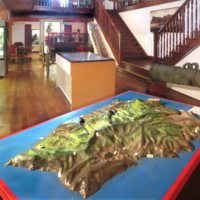
Museum of Saint Helena
The Museum of Saint Helena originated as a small natural history collection in 1854. Over the last 150 years it has moved three times before being officially opened in its current site in 2002 to mark the 500th anniversary of the island's discovery. It is housed in an eighteenth-century former power station in the island's capital, Jamestown. The museum explores the history of St Helena and it's position in the world. It has a large collection of physical artefacts supplemented by a digital archive of images, videos and audio.
The permanent exhibition offers a chronological view of Saint Helena's history, beginning with its geological development. The displays then explore the discovery of the island by European's, the role of the East India Company and migration. There is also a display about Napoleon Bonaparte's exile to Saint Helena.
Within the displays about colonisation and the East India Company are mentions of enslaved Africans brought to the island. Abolition and emancipation are also examined, as the interpretation moves on to explore the diverse make up of Saint Helena's population into the twentieth century. These displays are supported with artefacts and finds from recent archaeological digs on the island.
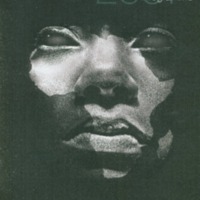
2007 Bicentenary for the Abolition of the Slave Trade Act at the National Maritime Museum
The National Maritime Museum marked the bicentenary with a range of initiatives and events including a new exhibition, a film season, poetry, music, debates, and new publications. A new permanent gallery opened at the museum in winter 2007 exploring Britain's Atlantic empire. A catalogue of slavery-related images, artefacts and documents from the collections of the museum, 'Representing Slavery', was published. The museum also devised a transatlantic slavery trail around Greenwich.
The National Maritime Museum hosted a number of events throughout 2007. The theme of the weekend 23-25 March was 'And still I rise', marked with a series of activities, performances and discussion. On August 23, International Day for the Remembrance of the Slave Trade and its Abolition, the ‘Freedom Festival: Contemporary Commemoration’ event saw a programme of creative events and performances exploring themes around the heritage of enslavement. The museum also offered a range of learning experiences based on its collections. For example, in November, a study session, 'Roots of Resistance: Abolition 1807' examined the roots of resistance and the abolition movement through talks by curators and contemporary artists. Activities for families were based on themes of freedom and carnival. 'The Big Conversation 2007' was a programme of debate and showcasing of diverse projects undertaken by students around the country, organised by the Understanding Slavery Initiative and the Department for Children, Schools and Families.
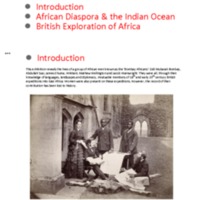
Bombay Africans
Bombay Africans 1850-1910 was exhibited at the Royal Geographical Society as part of the wider ‘Crossing Continents: Connecting Communities’ project, which with community partners aimed to develop new resources to advance the importance of geography. Based on the research of Clifford Pereira and with community consultation partners, Bombay Africans explored the histories of a group of African men who assisted British explorers such as John Hanning Speke, Richard Burton and David Livingstone on mapping expeditions in East Africa in the late 19th century. The name 'Bombay Africans' was given to Africans who had been rescued from the slave ships operating in the Indian Ocean. The exhibition examined the roles of these men in the anti-slavery movement and in Christian organisations like the Church Missionary Society. Focusing on the East Coast of Africa and the slave trade routes in the Indian Ocean, the exhibition also explored enslavement, forced migration, liberation and the African diaspora in the Asian subcontinent.
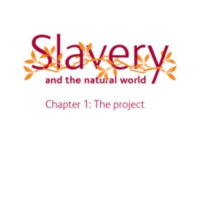
Slavery and the Natural World
In consultation with local community groups, in 2007 the Natural History Museum commissioned new research into its collections that link slavery and the natural world. The research uncovered experiences of enslaved people and the use of plants in their everyday life, as food, medicines and poisons. It also examined the complex relationships between enslaved people and naturalists exploring newly-colonised lands. The museum ran a series of public events, co-hosted by Race on the Agenda, which aimed to bring the historical, scientific and public viewpoints together. It created online educational resources on themes such as Commercial Plants, Everyday Life, Diet and Nutrition, and Resistance. The museum also developed cross-curricular ideas for school lessons in Science using the context of slavery, looking at foods across different cultures, for example.
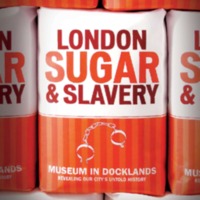
London, Sugar and Slavery
The Museum of London Docklands opened the London, Sugar and Slavery gallery in 2007, and it remains a permanent exhibition. The museum, housed in an old sugar warehouse on London’s West India Dock, retold the narrative of the transatlantic slave trade from the perspective of London, once the fourth largest slaving port in the world. Through personal accounts, film, music, interactive exhibits and over 140 objects, the exhibition looks at the various stages of the transatlantic slave trade, including life and trade on the West India Dock, and conditions for the enslaved on the Middle Passage and the Caribbean plantations. The final section of the gallery focuses on the legacies of the slave trade for British society today. Community collaborations also helped shape the gallery.
The museum also created a walking trail for the local area, highlighting key architectural features and buildings that had a role in the transatlantic slave trade. The Slave Map of London was developed in collaboration with three London museums: the Cuming Museum in Southwark, Bruce Castle Museum in Haringey and Fulham Palace Museum. Users navigated an online map to discover over 100 different locations throughout London which played a part in the transatlantic slave trade and the fight to end it. A schools programme that accompanied the opening of the exhibition included drama performances and workshops. Courses that ran alongside the exhibition in 2007 included ‘Resistance and Achievement: the story of African and Caribbean people in Britain’, in partnership with Middlesex University.
In 2018, the museum reflected on the 10 year anniversary of London, Sugar and Slavery with a workshop to explore the significance of the gallery, with contributions from artists, museum practitioners and emerging artists.

'Irreconcilable with the principles of justice and humanity': the trade in slaves and its abolition
An exhibition held in the Special Collections Gallery at the Hartley Library, University of Southampton. The exhibition took a broad view of the subject of transatlantic slavery across the 18th and 19th centuries, featuring accounts of the horrors of the transatlantic slave trade, the case for abolition, and contemporary tracts and pamphlets putting forward the arguments for total abolition. Alongside these were discussions of the place of slavery in the economy of the West Indies, and the detail of measures taken by governments, such as that of the first Duke of Wellington in 1828-30, and the work of the third Viscount Palmerston, as Foreign Secretary and Prime Minister. The exhibition also looked at the efforts of the Royal Navy to enforce legislation and treaties against slave trading.
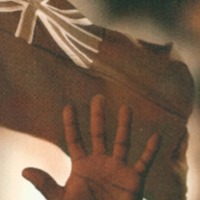
Chasing Freedom: The Royal Navy and the Suppression of the Transatlantic Slave Trade
An exhibition at the Royal Naval Museum at Portsmouth Historic Dockyard explored the role of the Royal Navy squadron established after 1807 to patrol the West African coast and suppress the transatlantic slave trade. Using illustrations, contemporary accounts and original diaries of Royal Navy personnel, the exhibition examined key aspects of the campaign against Atlantic slave traders. It also looked at the Royal Navy's efforts against human trafficking and in the pursuance of humanitarian rights today. There was an accompanying programme of schools workshops and community events. Two specially produced films discussed the legacy of the squadron's work and recreated the abolition debates of the time.
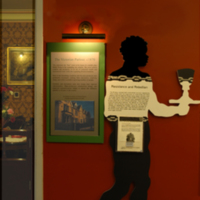
Unfair Trade
York Castle Museum's Unfair Trade exhibition used the museum's collections to explore slavery from the viewpoint of ordinary people, and how consumption of slave-produced everyday commodities - sugar, tea, coffee, cocoa - contributed to the slave trade. It also looked at the part played by York in the abolition of the slave trade and slavery, with the many Quakers of the city supporting William Wilberforce and helping to finance his election campaign. The exhibition continued the focus on consumption into modern life by asking visitors to consider where the products they buy come from. York Castle Museum features a recreated Victorian street, Kirkgate, with its own newspaper, 'The Kirkgate Examiner'. A special edition was distributed to coincide with the exhibition.
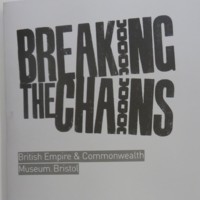
Breaking the Chains
Breaking the Chains opened at the British Empire and Commonwealth Museum to coincide with the bicentenary, and told the story of the British transatlantic slave trade and its abolition. Developed in partnership with Bristol City Council's Museums, Galleries and Archives' Service, the exhibition used artefacts, film and testimony to challenge perceptions about Britain's involvement in the slave trade and its legacy today. It featured a multimedia gallery of digital memories and feelings on the contemporary legacies of the slave trade; interactive sound stations to see and hear personal testimonies and the power of black music; and the ‘Me deya’ gallery, led by Firstborn Creatives, a collection of work from artists and communities who wished to share their creative pieces about the legacies of the slave trade. Associated events included African music for children, community dance events and public debates.
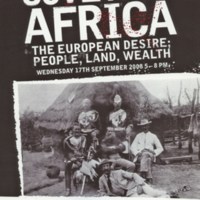
Coveting Africa. The European Desire: People, Land, Wealth
Bishop’s Stortford was the birthplace of the Victorian financier and imperialist Cecil Rhodes. To commemorate the bicentenary of the Abolition Act, Bishop's Stortford Museum and Rhodes Art Complex explored Britain’s imperial ambitions in the ‘Coveting Africa’ exhibition. The museum holds much material from Southern Africa, Zimbabwe, Zambia and Botswana: areas where British colonialism and imperialism in Africa was focused in the nineteenth century. Through a year-long programme of arts events, this project discussed the relationship between Britain and Africa, and explored British attitudes to African peoples. Events included workshops by the London School of Capoeira.
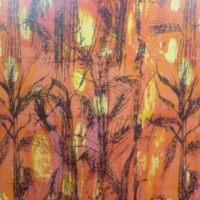
Trade and Empire: Remembering Slavery
The Whitworth Art Gallery was one of eight heritage bodies in the ‘Revealing Histories: Remembering Slavery’ partnership in Greater Manchester. The project set out to explore the history, impact and legacy of slavery on Britain through collections and community links in the North West.
'Trade and Empire: Remembering Slavery' explored the themes of trade and empire, commerce and collecting, and the impact of the experience of slavery and its legacy. Four invited artists and academics (SuAndi, Kevin Dalton-Johnson, Dr Emma Poulter and Dr Alan Rice) worked with Whitworth curators and learning staff to create the exhibition. It comprised of selections from the Whitworth's collections, contemporary works by Black artists, and objects on loan from Manchester Museum, John Rylands University Library Manchester, Bolton Museums and Archives Service and private collections. Areas of focus included a history of the Benin Bronzes, representations of Black people in British art, photographs of West Africa belonging to Tom Singleton Gardner, and printed textiles designed by Althea McNish. The exhibition was accompanied by a series of community engagement events.
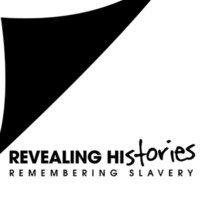
Revealing Histories: Remembering Slavery
The Revealing Histories: Remembering Slavery project sought to uncover the North West's involvement in the slave trade (and the consequent social and economic effects of this involvement) and the region's contribution to the abolition of the transatlantic slave trade and colonial slavery. Eight museums and galleries across Greater Manchester collaborated to commemorate the lasting legacies of the transatlantic slave trade. The participating venues were: Bolton Museum and Archive Service; Gallery Oldham; Manchester Art Gallery; The Manchester Museum; Museum of Science and Industry; People's History Museum; Touchstones Rochdale; and Whitworth Art Gallery. A collaborative website and a programme of exhibitions, trails, performances, films and events took a new look at the collections of these museums and galleries and the buildings in which they are housed, revealing hidden histories of the region's involvement in the slave trade. The project also examined slavery's contemporary legacy and relevance.
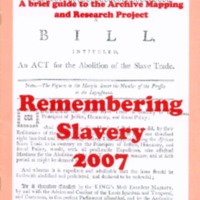
Remembering Slavery Archive and Mapping Project
Remembering Slavery 2007 involved museums, galleries and other cultural organisations across the North East of England in a programme of exhibitions, events, performances, lectures and activities to explore the themes of slavery and abolition, and identify connections with the region.
The Remembering Slavery Archive Mapping and Research Project, led by the Literary and Philosophical Society in Newcastle and assisted by local history groups, uncovered a large amount of archival material in the region’s institutions, exposing many hitherto unknown links between the North East and the slave trade. The participating record offices and libraries were Tyne and Wear Archives Service, the Literary and Philosophical Society Library, the Northumberland Record Office and the Robinson Library’s Special Collections at the University of Newcastle upon Tyne. This reassessment of the North East’s involvement in slavery and the slave trade led to new published research, including John Charlton's 'Hidden Chains: the Slavery Business and North East of England 1600-1865'. There was also a lecture programme at the Literary and Philosophical Society, including talks by Professor James Walvin. Several of the project volunteers published essays based on their research in 'North East History 39' (North East Labour History Society, 2008). The North East Slavery and Abolition Group was established among the project volunteers, and further work on slavery and abolition was included in the Society’s North East Popular Politics project (NEPPP), 2010-13. Much of the material found in the 2007 project has been loaded onto the NEPPP database.
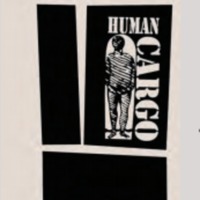
Human Cargo: The Transatlantic Slave Trade, its Abolition and Contemporary Legacies in Plymouth and Devon
Human Cargo was a partnership project between Plymouth City Museum and Art Gallery, and the Royal Albert Memorial Museum, Exeter. The project consisted of two main components. The first was a historical exhibition, which explored the development of the transatlantic slave trade and, in particular, the role of Plymouth as a port, the involvement of the City's dignitaries and the South West's links with the abolition movement. The second part was a contemporary art response to modern forms of slavery and historical legacies, including the flower picking trade, sweatshop labour and the Fair Trade Movement. This work was newly commissioned and included audio visual pieces, installations, hand-printed wallpaper and participatory objects. A variety of events and activities took place alongside the exhibition including education workshops, performances, African music and storytelling activities, and Elizabethan House re-enactment sessions.
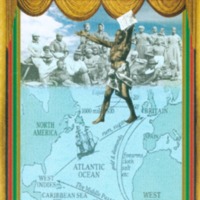
Leeds Bicentenary Transformation Project
This collaborative community initiative celebrated African and Caribbean culture in Leeds, with a focus on commemorating the Abolition Act by 'highlighting African achievement, liberation and aspirations'. New exhibitions, publications and resources were produced and over 100 bicentenary events organised under different themes: Education and Museums; Arts and Carnival Culture; Churches and Abolition; Legacy; Black History and Community Development; Media and Communications. Highlights included the photographic exhibition and pamphlet 'From Abolition to Commonwealth', which remembered indentured labour in Africa and the Caribbean after 1807, and the 40th anniversary of Leeds West Indian Carnival, with themes that highlighted heritage, liberation, respect and freedom. Project outputs included an education pack, black history classes, concerts, church services, lectures and performances.